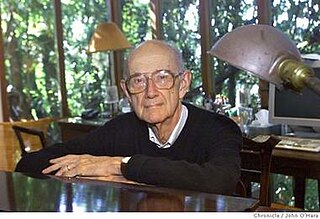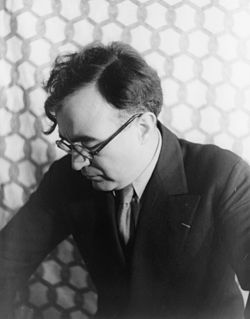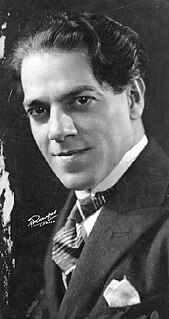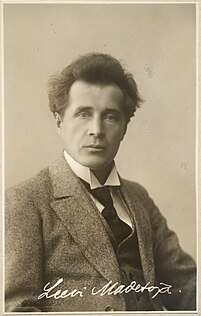Related Research Articles

Antal Doráti was a Hungarian-born conductor and composer who became a naturalized American citizen in 1943.

Roger Huntington Sessions was an American composer, teacher and writer on music.

Andrew Welsh Imbrie was an American contemporary classical music composer and pianist.
Christian Badea is a Romanian-American opera and symphonic conductor.

Montezuma is an opera in three acts by the American composer Roger Sessions, with an English libretto by Giuseppe Antonio Borgese that incorporates bits of the Aztec language, Nahuatl, as well as Spanish, Latin, and French.
The Symphony No. 6 of Roger Sessions, a symphony written using the twelve-tone technique, was composed in 1966. It was commissioned by the state of New Jersey and the New Jersey Symphony Orchestra. The score carries the dedication: "In celebration of the three hundredth anniversary of the state of New Jersey".
The Symphony No. 5 of Roger Sessions was commissioned in 1960 and completed in 1964. It was commissioned by Eugene Ormandy and the Philadelphia Orchestra, and the first movement only was premiered by them in February 1964, the rest not being completed until that December.
The Symphony No. 2 of Roger Sessions was begun in 1944 and completed in 1946.
The Symphony No. 3 of Roger Sessions was written in 1957. It was a result of a commission by the Koussevitzky Foundation to celebrate the 75th anniversary of the Boston Symphony Orchestra, and was premiered by the Boston Symphony on December 6, 1957, conducted by Charles Munch. Sessions later was commissioned by the Boston Symphony on their centenary, when he provided them with his Concerto for Orchestra. Andrea Olmstead describes all of Sessions's symphonies as "serious" and "funereal", with No. 3 being one of four with, "quiet reflective endings."
The Symphony No. 7 of Roger Sessions was written in 1967 for the 150th anniversary of the University of Michigan. It was premiered in Ann Arbor, Michigan, on October 1, 1967, by the Chicago Symphony Orchestra, conducted by Jean Martinon.
The Symphony No. 1 of Roger Sessions is a symphony in three movements, in E minor.
The Symphony No. 8 of Roger Sessions was composed in 1968.
Roger Sessions' Violin Concerto was composed between 1927 and 1935, and is scored for violin and orchestra.
Cecil Effinger was an American composer, oboist, and inventor.

Caballos de vapor, sinfonía de baile is a ballet score composed by the Mexican composer Carlos Chávez in 1926–32. A shortened concert version is published as Suite sinfónica del ballet Caballos de vapor.
The Third Essay, Op. 47, is a short orchestral work composed by Samuel Barber in 1978. The score is dedicated to Audrey Sheldon.
The Concerto for Orchestra is a composition for orchestra by the American composer Roger Sessions. The work was commissioned by the Boston Symphony Orchestra and premiered October 23, 1981, with conductor Seiji Ozawa leading the Boston Symphony Orchestra. The concerto was Sessions's last orchestral composition and won him the 1982 Pulitzer Prize for Music. Sessions had previously won a special lifetime achievement Pulitzer Prize in 1974 "for his life's work as a distinguished American composer." The piece was honored with a performance at the closing of the 50th Tanglewood Music Festival in 2014.
The Symphony No. 9 by Roger Sessions is a symphony in three movements, completed in 1978. A performance lasts about 28 minutes.

Symphony No. 10, Sumé pater patrium: Sinfonia ameríndia com coros (Oratorio) is a composition by the Brazilian composer Heitor Villa-Lobos, written in 1952–53. The broadcast performance of the world-premiere performance under the composer's direction lasts just over 67 minutes.

Elegia, Op. 4/1, is a composition for string orchestra by the Finnish composer Leevi Madetoja, who wrote the piece in 1909 during his student years. On 10 January 1910, Robert Kajanus, chief conductor of the Helsinki Orchestral Society, premiered the Elegia to great acclaim, with the piece described as the "first master work" of a budding "natural orchestral composer". Madetoja subsequently designated the Elegia as the first number in his four-movement Sinfoninen sarja, Op. 4, which the Helsinki Orchestral Society performed in its entirety under the composer's baton on 26 September 1910. The suite's three other numbers are virtually unknown, and the Elegia typically is performed as a stand-alone concert piece. Stylistically reminiscent of Tchaikovsky, it is, to date, Madetoja's most recorded and well-known orchestral composition, as well as the most enduringly popular of his many miniatures.
References
- ↑ The last page of the score as published is signed with the date of completion.
- ↑ Opening of Elegy is quoted as example 6 in Imbrie. Imbrie, Andrew (1972). "The Symphonies of Roger Sessions". Tempo. New Series (103): 24–32. ISSN 0040-2982. JSTOR 943951. OCLC 1767255.
- ↑ Marks Music Corporation 1963 score.
- ↑ Helm, Everett (May 1960). "Reports from Abroad". Musical Times. Musical Times Publications Ltd. 101 (1407): 316–7. ISSN 0027-4666. OCLC 53165808.
- ↑ "Roger Sessions: Compositions" . Retrieved 23 May 2009.
- ↑ Prausnitz (2002), Roger Sessions: How a "Difficult" Composer Got That Way at Google Books; p. 281; Steinberg, Choral Masterworks at Google Books, p. 253.
- ↑ Badea's recording on New World;[ failed verification ] Marks Music score.[ failed verification ]
- ↑ Olmstead, Andrea (2012). Roger Sessions: A Biography, p.356. Routledge. ISBN 9781135868925.